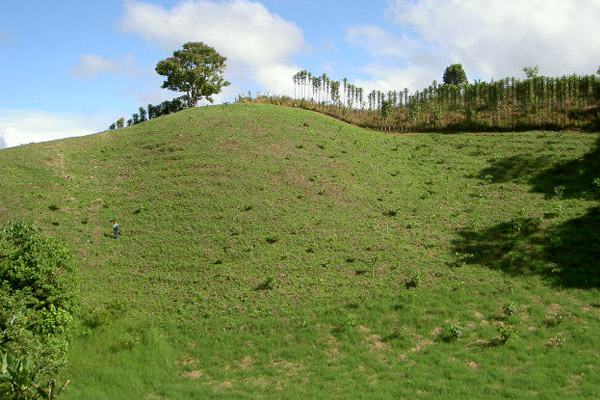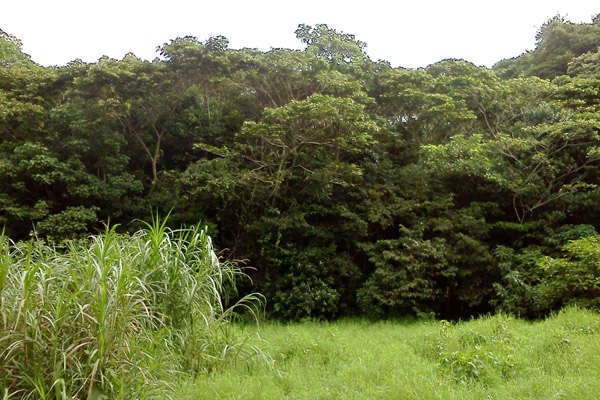Worldwide, large swaths of land lay barren in the wake of agricultural expansion, and as global forest cover continues to decline, carbon and water cycles, biodiversity, and human health are impacted. But efforts to restore abandoned pastures and agricultural plots back into functioning forest ecosystems are often hindered by high costs and time requirements. Fortunately, scientists have developed a new method for a more cost effective solution to forest restoration, the establishment of “tree islands.”
Typically, forest restoration involves planting rows of trees, plantation style, which cover the entire restoration site. However, a team of researchers led by Rakan A. Zahawi of Las Cruces Biological Station in Costa Rica and Karen Holl of UC Santa Cruz recently tested an innovative method known as applied nucleation or the “tree island method” to facilitate forest recovery. In the tree island method, clusters of trees are spread out across the site instead of covering the whole deforested area. For this study, the researchers tested three different treatments on abandoned pasture plots in Costa Rica: planting tree islands, plantation style planting, and no planting or what is known as “passive restoration.”
“We were surprised,” Karen Holl told mongabay.com, “that the applied nucleation strategy was as effective in facilitating the natural establishment of forest tree seedlings as planting the entire area with trees, even though we only planted 27% of the trees in the applied nucleation treatment.”

Two-toed sloth hanging out in tree plantation five years after planting began. Photo by: J.L. Reid.
The establishment of tree islands, around the size of 100m2, serves as an “activation energy” of sorts. As the trees grow, they shade out competitive pasture grasses and also attract frugivorous (i.e fruit-eating) birds that spread the tree seeds around. Once the bird-dispersed trees reach maturity, they provide habitat for more seed dispersing birds and animals, which will bring more seeds. Once this ecological process is jump-started successfully, it should proceed without further intervention.
“There are large areas of degraded lands in the tropics that are in need of restoration and there simply aren’t enough resources to do so,” says Holl. “The overarching goal for the tree island method is that we will be able to restore forest in former agricultural lands in a more economical manner so larger areas can be restored with the added benefit that this restoration approach will create habitat conditions that are more similar to the forest than planting trees in straight lines.”
The biggest obstacles to implementing the tree island method on a large scale are logistical. It can be more difficult for land managers to plant in irregular planting designs, and rows of tree seedlings may be easier to maintain, especially if the maintenance is mechanized (irrigation lines, mowing, etc.) There are also issues with how people perceive the idea of planting tree islands.
“We have had questions from farmers who want to know why we are only planting part of the site with trees rather than the whole area,” notes Holl. In other words, people are more familiar with a standard plantation-style design. This requires additional education about the goals of forest restoration.”
Additionally, Holl calls for more long-term research. “There are many studies of forest restoration that are five years or less. But, forests take decades to recover and there are very few long-term studies of forest restoration. We know that planting trees in rows and in tree islands help speed up forest recovery early on in forest succession. But, we honestly don’t know if it will make a difference over the longer term.”

Site of replanting. Photo courtesy of Karen Holl.

Forest eight years after replanting. Photo courtesy of Karen Holl.
Citations:
- Zahawi, Rakan A., Karen D. Holl, Rebecca J. Cole, and J. Leighton Reid. Testing applied nucleation as a strategy to facilitate tropical forest recovery. Journal of Applied Ecology. 50. (2013): 88-96.
Related articles
Scientists: well-managed forest restoration benefits both biodiversity and people
(12/16/2013) In November this year, the world was greeted by the dismaying news that deforestation of the Brazilian Amazon jumped 28% in the past year. The year 2013 also holds the dubious distinction of being the first time since humans appeared on the planet, that carbon concentrations in the atmosphere rose to 400 parts per million. A map by Google revealed that Russia, Brazil, the United States, Canada and Indonesia all displayed over 10 million hectares of gross forest loss from 2000-2012, with the highest deforestation rate occurring in Malaysia.
Reforestation can’t offset massive fossil fuels emissions

(12/13/2013) With the Australian, Japanese, and Canadian governments making an about-face on carbon-emissions reduction targets during the Warsaw climate summit, some experts are warning that the global need for solutions offsetting CO2 emissions is passing a “red line.” Land-based mitigation practices comprise one of the solutions on the table as a result of both the United Nations Framework Convention on Climate Change (UFCCC) and the Kyoto Protocol; however, a paper published in Nature Climate Change by an international team led by Brendan Mackey, has raised the looming question of whether or not land-based practices can actually improve CO2 levels as much as hoped.
Climate change could kill off Andean cloud forests, home to thousands of species found nowhere else

(09/18/2013) One of the richest ecosystems on the planet may not survive a hotter climate without human help, according to a sobering new paper in the open source journal PLoS ONE. Although little-studied compared to lowland rainforests, the cloud forests of the Andes are known to harbor explosions of life, including thousands of species found nowhere else. Many of these species—from airy ferns to beautiful orchids to tiny frogs—thrive in small ranges that are temperature-dependent. But what happens when the climate heats up?
Paper giant APRIL to restore peat forest in Sumatra, but green groups say it continues to deforest
(05/14/2013) Pulp and paper giant Asia Pacific Resources International Limited (APRIL) has launched a $7 million ecosystem restoration project to restore and protect over 20,000 hectares of peat forest in Indonesia’s Riau province, Mongabay-Indonesia reported last week.
Disney buys $3.5M in REDD credits from rainforest conservation project in Peru
(03/20/2013) The Walt Disney Company has purchased $3.5 million dollars’ worth of carbon credits generated via rainforest conservation in Peru, reports Point Carbon.
Will Amazon species lose the climate change race?

(02/14/2013) Deforestation could increase the risk of biodiversity loss in the Amazon by forcing species to migrate further in order to remain at equilibrium with changing climates, says new research. “As migration models are made more realistic through the inclusion of multiple climatic, biotic, abiotic and human factors, the predicted distances between current and future climate analogues invariably increases,” Kenneth Feeley, lead author of the paper published in Global Change Biology, told mongabay.com.
Recovery of Atlantic Forest depends on land-use histories
(12/10/2012) The intensity of land-use influences the speed of regeneration in tropical rainforests, says new research. Tropical rainforests are a priority for biodiversity conservation; they are hotspots of endemism but also some of the most threatened global habitats. The Atlantic Forest stands out among tropical rainforests, hosting an estimated 8,000 species of endemic plants and more than 650 endemic vertebrates. However, only around 11 percent of these forests now remain.